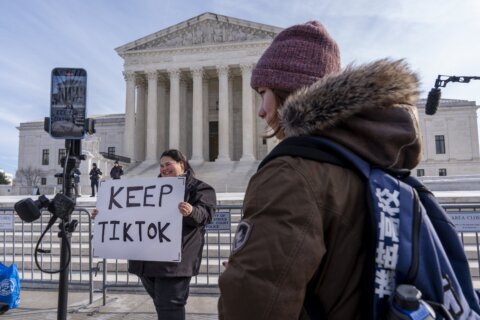WASHINGTON (AP) — Laid off by the music streaming service Spotify last year, Joovay Arias figured he’d land another job as a software engineer fairly soon. His previous job search, in 2019, had been a breeze.
“Back then,” he said, “I had tons of recruiters reaching out to me — to the point where I had to turn them down.”
Arias did find another job recently, but only after an unexpected ordeal.
“I thought it was going to be something like three months,’’ said Arias, 39. “It turned into a year and three months.’’
As Arias and other jobseekers can attest, the American labor market, red-hot for the past few years, has cooled. The job market is now in an unusual place: Jobholders are mostly secure, with layoffs low, historically speaking. Yet the pace of hiring has slowed, and landing a job has become harder. On Friday, the government will report on whether hiring slowed sharply again in August after a much-weaker-than-expected July job gain.
“If you have a job and you’re happy with that job and you want to hold onto that job, things are pretty good right now,” said Nick Bunker, economic research director for North America at the Indeed Hiring Lab. “But if you’re out of work or you have a job and you want to switch to a new one, things aren’t as rosy as they were a couple of years ago.’’
Since peaking in March 2022 as the economy accelerated out of the pandemic recession, the number of listed job openings has dropped by more than a third, according to the government’s latest monthly report on openings and hiring.
Temporary-help firms have reduced jobs for 26 of the past 28 months. That’s a telling sign: Economists generally regard temp jobs as a harbinger for where the job market is headed because many employers hire temps before committing to full-time hires.
In a roundup this week of local economic conditions, the Federal Reserve’s regional banks reported signs of a decelerating job market. Staffing agencies have said that job gains have slowed “as firms are approaching hiring decisions with greater hesitancy,” the New York Fed found. “Job candidates are lingering on the market longer.”
The Minneapolis Fed said that a staffing agency reported that “businesses are getting a lot more picky” about whom they hire. And the Atlanta Fed found that “only a few” companies planned to step up hiring.
Job-hopping, so rampant two years ago, has slowed as workers have gradually lost confidence in their ability to find better pay or working conditions somewhere else. Just 3.3 million Americans quit their jobs in July, compared with a peak of 4.5 million in April 2022.
“People are staying put because they’re afraid they won’t find new jobs,’’ said Aaron Terrazas, chief economist at the employment website Glassdoor.
And the Labor Department has reported, in its annual revised estimates of employment growth, that the economy added 818,000 fewer jobs in the 12 months that ended in March than it had previously estimated.
In one respect, it’s not at all surprising that the pace of hiring is now moderating. Job growth in 2021 and 2022, as the economy roared back from the COVID-19 recession, was the most explosive on record. Workers gained leverage they hadn’t enjoyed in decades. Companies scrambled to hire fast enough to keep up with surging sales. Many employers had to jack up pay and offer bonuses to keep employees.
It was inevitable — and even healthy, economists say, in the long run — for hiring to slow, thereby easing pressure on wage growth and inflation pressures. Otherwise, the economy could have overheated and forced the Fed to tighten credit so aggressively as to cause a recession.
The post-pandemic jobs boom was a marked contrast to the sluggish recovery from the Great Recession of 2007-2009. Back then, it took more than six years for the economy to recover the jobs that had been lost. By contrast, the breathtaking pandemic job losses of 2020 — 22 million — were reversed in less than 2 1/2 years.
Still, the surging economy ignited inflation, leading the Fed to raise interest rates 11 times in 2022 and 2023 to try to cool the job market and slow inflation. And for a while, the economy and the job market appeared immune from higher borrowing costs. Consumers kept spending, businesses kept expanding and the economy kept growing.
But eventually the continued high rates began leaving their mark. Several high-profile companies, including tech giants like Spotify, announced layoffs last year in the face high interest rates. Outside of the economy’s technology sector, though, and, to a lesser extent, finance, most American companies haven’t cut jobs. The number of people filing first-time applications for unemployment benefits is barely above where it was before the pandemic struck.
Yet the same companies that are keeping workers aren’t necessarily adding more.
“Compared to a year or two ago, it’s a lot more difficult, particularly for entry-level folks,’’ Glassdoor’s Terrazas said. “Because of the gradual drip of layoffs in tech and finance, in professional services over the past year and a half, there have been a lot of high-skilled, experienced folks on the job market.
“By all evidence, they are finding jobs. But they are also pushing more entry-level folks further and further down the queue… Recent grads, folks without a lot of on-the-job experience are feeling the effects of suddenly competing with people who have two, five, 10 years’ experience in the jobs market. When those big fish are in the market, the little fish naturally get squeezed out.’’
Copyright © 2025 The Associated Press. All rights reserved. This material may not be published, broadcast, written or redistributed.









